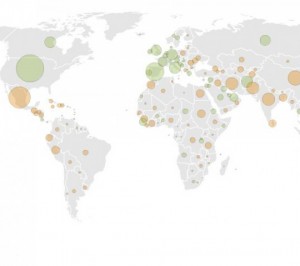Snapshot of global migration
 In 2007 Ireland elected a Nigerian-born man as its first black mayor.
In 2007 Ireland elected a Nigerian-born man as its first black mayor.
Late last year a Hamas rocket landed in Israel killing a farmworker. Not so unusual, except that the worker was Thai.
These two unrelated incidents are indicative of a significant global trend – more people than ever are living abroad.
In 2013, 232 million people, or 3.2 per cent of the world’s population, were international migrants, compared with 175 million in 2000 and 154 million in 1990.
A new snapshot of global migration, created using data gathered over the past decade, gives the first comprehensive view of human relocations across the planet.
The snapshot, produced using data from the United Nations, The World Bank and the IMF, is encapsulated in five fascinating maps.
The maps show Australia, with a population of just 22 million, is a significant nation in the overall picture of global migration.
The data shows Europe and Asia combined host nearly two-thirds of all international migrants worldwide. Europe remains the most popular destination region with 72 million international migrants in 2013, compared to 71 million in Asia.
Since 1990, Northern America recorded the largest gain in the absolute number of international migrants, adding 25 million, and experienced the fastest growth in migrant stock by an average of 2.8 per cent per year.
“New sources and destinations of migrants are emerging, and in some cases, countries have become important points of origin, transit and destination simultaneously,” said John Wilmoth, Director of the Population Division in the UN’s Department of Economic and Social Affairs.
Compared to other regions of destination, Asia saw the largest increase of international migrants since 2000, adding some 20 million migrants in 13 years. Mr Wilmoth said this growth was mainly fuelled by the increasing demand for foreign labour in the oil-producing countries of Western Asia and in South-Eastern Asian countries with rapidly growing economies, such as Malaysia, Singapore and Thailand.
In 2013, half of all international migrants lived in 10 countries, with the US hosting the largest number (45.8 million), followed by the Russian Federation (11 million); Germany (9.8 million); Saudi Arabia (9.1 million); United Arab Emirates (7.8 million); United Kingdom (7.8 million); France (7.4 million); Canada (7.3 million); Australia (6.5 million); and Spain (6.5 million).
There are as many international migrants born in developing countries living in other developing countries as in developed countries, reflecting changing patterns of Asian migration, the data shows.
Developed countries are home to 136 million international migrants, compared to 96 million in developing countries. Most international migrants are of working age (20 to 64 years) and account for 74 per cent of the total. Globally, women account for 48 per cent of all international migrants.
Asians and Latin Americans living outside of their home regions form the largest global diaspora groups. In 2013, Asians represented the largest group, accounting for about 19 million migrants living in Europe, some 16 million in Northern America and about 3 million in Oceania. Migrants born in Latin America and the Caribbean represented the second largest diaspora group with the majority, 26 million, living in Northern America.
In 2013, South Asians were the largest group of international migrants living outside of their home region. Of the 36 million international migrants from South Asia, 13.5 million resided in the oil-producing countries in Western Asia.
International migrants originating from Central America, including Mexico, represented another large group of migrants living outside their home region. About 16.3 million, out of 17.4 million Central American migrants lived in the US.
The US gained the largest absolute number of international migrants between 1990 and 2013—nearly 23 million, equal to one million additional migrants per year. The United Arab Emirates recorded the second largest gain with seven million, followed by Spain with six million.












